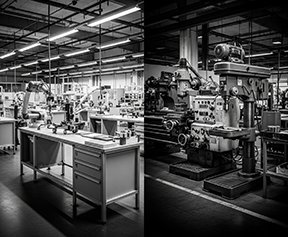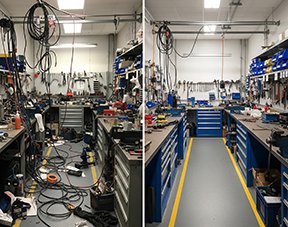Published: July 08, 2014 | Updated: September 16, 2025
Published: July 08, 2014 | Updated: September 16, 2025
Efficiency in Action: Quotes that Embody Lean Manufacturing
 Lean manufacturing stands as one of the most transformative approaches in industrial settings. From assembly lines to maintenance departments, its focus on reducing waste and improving productivity has reshaped countless workflows. This article, gathers enduring quotes that embody lean manufacturing. More than just memorable words, these quotes capture the spirit of lean culture and the philosophy that powers it.
Lean manufacturing stands as one of the most transformative approaches in industrial settings. From assembly lines to maintenance departments, its focus on reducing waste and improving productivity has reshaped countless workflows. This article, gathers enduring quotes that embody lean manufacturing. More than just memorable words, these quotes capture the spirit of lean culture and the philosophy that powers it.
The Foundation of Lean: Waste Reduction and Value Creation
At its core, lean manufacturing hinges on two essential goals: reducing waste and adding value. Anything that does not contribute directly to a product's usefulness or customer satisfaction counts as waste. Overproduction, idle time, redundant motion, excess inventory—these remain top offenders. In the realm of maintenance, inefficiencies often include poor planning, reactive strategies, and underutilized data. A lean mindset involves more than cost-saving; it rethinks the entire system to eliminate unnecessary steps and promote clarity of purpose.
Lean Maintenance: A Practical Expression of the Philosophy
Lean maintenance focuses on avoiding breakdowns before they start. That means deploying planned maintenance schedules, predictive technologies, and tools like a computerized maintenance management system (CMMS). Organizations that implement these practices often see smoother operations and fewer unexpected delays. Equipment uptime increases, and so does workforce efficiency. Rather than constantly reacting to issues, teams prevent them through structure, foresight, and data.
Timeless Quotes That Embody Lean Thinking
Do It Right the First Time
"If you don't have time to do it right, you must have time to do it over." This quote from John Wooden resonates deeply with production environments. Rushed jobs lead to errors. Errors lead to rework. Rework wastes time and resources. Getting it right on the first pass doesn't just save labor—it reinforces a culture of diligence and precision.
Ideas Need Legs
"Great ideas need landing gear as well as wings," said C.D. Jackson. The most innovative maintenance strategies remain useless without a plan to ground them. Actionable steps transform visions into operations. A well-crafted preventative maintenance plan doesn't just exist on paper—it lives on factory floors and within team routines.
Discover how streamlined maintenance processes can elevate production. Learn more.
Think First, Then Act
"Invest a few moments in thinking. It will pay good interest." Strategic thinking shapes the future of manufacturing. Allocating time for thoughtful planning avoids hasty decisions that become costly later. The act of pausing to reflect before execution often separates high-performing teams from the rest
Stop Nurturing Waste
"Don't water your weeds," said Harvey Mackay. This metaphor applies to bloated systems and inefficient practices. Every process should add value. If it doesn't, it deserves scrutiny or elimination. Persistent evaluation fuels lean improvements, not letting bad ideas become operational mainstays.
The People Factor: Efficiency Without Dehumanization
Efficiency shouldn't strip away humanity. Al Diamond once quipped, "If all efficiency experts were laid end to end, I'd be in favor of it." Felix Frankfurter added, "I don't like a man to be too efficient. He's likely to be not human enough." Behind every machine stands a human. Systems may seek precision, but people need balance, respect, and room to grow. Lean succeeds best when it values people as well as process.
Beyond Short-Term Setbacks
"You must have long-range goals to keep you from being frustrated by short-term failures." This quote from Charles C. Noble reminds industrial leaders that setbacks don't define success. Challenges arise. A long view ensures resilience, guiding teams through turbulence toward steady progress.
Test the Impossible
"The impossible is often the untried." Jim Goodwin's words encourage experimentation. Problems that seem insurmountable may simply require new thinking. Lean principles welcome this kind of exploration. Avoiding the status quo keeps companies nimble.
Time Has Edges
C. Northcote Parkinson observed, "Work expands to fill the time available for its completion." Without deadlines or accountability, even simple tasks balloon. In lean environments, timing matters. Set clear expectations, monitor pacing, and allocate responsibilities based on strengths.
Know Your Direction
"If you don't know where you are going, you will probably end up somewhere else." Lawrence J. Peter speaks directly to strategic planning. Maintenance programs without targets wander aimlessly. Clarity ensures every team member works toward a unified outcome.
Change the Thinking, Change the System
Albert Einstein's insight—"The world we have created is a product of our thinking; it cannot be changed without changing our thinking"—captures the essence of lean transformation. Thought patterns dictate process design. Lean invites introspection and innovation, even at the most foundational level.
How CMMS Accelerates Lean Ideals
A CMMS does more than digitize maintenance—it acts as a direct enabler of the values behind every quote mentioned above. CMMS platforms structure maintenance schedules so tasks happen before failure occurs. They enforce the mindset of "do it right the first time" by automating documentation, checklists, and follow-ups. With data-rich dashboards, a CMMS supports long-term goal tracking and offers a tangible view of continuous improvement.
Visualizing equipment histories, labor trends, and failure patterns reduces reliance on guesswork. Strategic thinking becomes measurable. Real-time alerts prevent unnecessary downtime, keeping the "landing gear" on great ideas. With reporting features and KPI monitoring, a CMMS fuels strategic reflection, aligning perfectly with lean's focus on targeted improvements and value creation.
Visual Management as a Lean Tool
 Visual management tools make lean principles visible and tangible. Floor markings, shadow boards, and digital dashboards all help communicate standards quickly. When workers can see what good looks like, they stay aligned with expectations. Transparency replaces confusion. Waste hides in ambiguity; visibility brings it into the open. In maintenance, especially, visual cues for inspection status, parts inventory, and equipment health reduce downtime and keep everyone on track.
Visual management tools make lean principles visible and tangible. Floor markings, shadow boards, and digital dashboards all help communicate standards quickly. When workers can see what good looks like, they stay aligned with expectations. Transparency replaces confusion. Waste hides in ambiguity; visibility brings it into the open. In maintenance, especially, visual cues for inspection status, parts inventory, and equipment health reduce downtime and keep everyone on track.
A CMMS expands the power of visual management by digitizing and centralizing these visual cues. It delivers real-time dashboards that illustrate work order status, overdue tasks, upcoming inspections, and resource allocation. Color-coded alerts replace guesswork with actionable insight. Equipment conditions, flagged by sensor data or technician notes, show up clearly—reducing uncertainty and preventing delays.
Instead of relying on manual updates or wall charts, teams interact with visual data through tablets, kiosks, or large screens on the production floor. Every technician knows what tasks are due, which assets need priority attention, and where spare parts are located. With the CMMS acting as a dynamic communication hub, decision-makers and technicians work from the same set of live, visual information—creating cohesion and reducing friction. Visual management moves from passive display to interactive command center.
Let the Questions Lead
Great systems don't grow from complacency—they thrive on the courage to ask better questions. What doesn't need to be done? Where is value truly created? What would a simpler version of this process look like? These questions reveal lean's true power: not just as a method, but as a lens for seeing things differently.
FAQs
What is lean manufacturing and why is it important?
Lean manufacturing focuses on reducing waste and improving productivity to create more value in industrial operations.
How does CMMS support lean maintenance principles?
A CMMS schedules preventive maintenance, tracks equipment history, and enforces “do it right the first time” practices to reduce downtime and inefficiency.
Can MAPCON’s CMMS help implement lean strategies in a factory?
Yes, MAPCON’s CMMS centralizes maintenance data, monitors KPIs, and supports continuous improvement initiatives aligned with lean philosophy.
Why is visual management critical in lean manufacturing?
Visual tools and dashboards make standards, tasks, and equipment status clear, reducing confusion and improving workflow efficiency.
How does lean maintenance improve workforce productivity?
By preventing equipment failures and providing structured schedules, lean maintenance allows workers to focus on value-adding tasks instead of reacting to breakdowns.
What types of data and reports can a CMMS provide for lean operations?
CMMS platforms provide dashboards, work order histories, KPI tracking, and equipment performance reports to drive informed, strategic decisions.
MAPCON | 800-922-4336
MAPCON CMMS software empowers you to plan and execute PM tasks flawlessly, thanks to its wealth of features and customizable options. Want to see it for yourself? Click the button below to get your FREE 30-day trial of MAPCON!
Try It FREE!